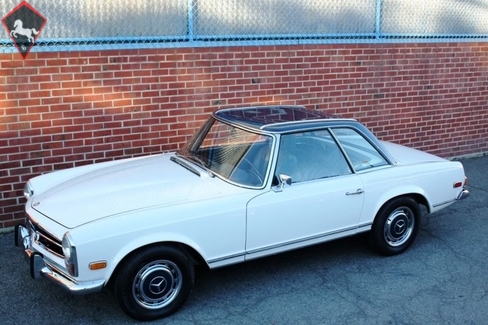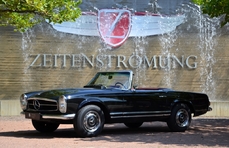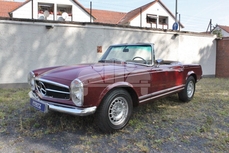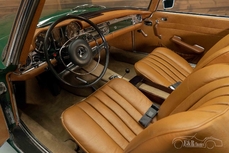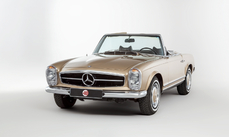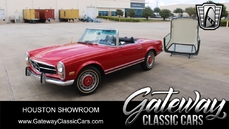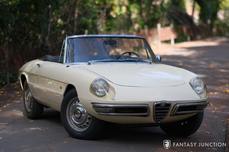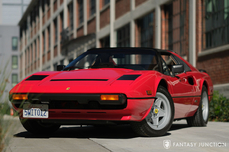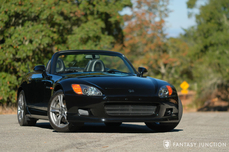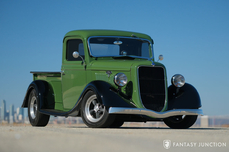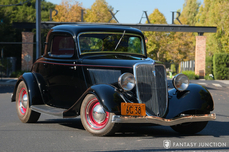Mercedes-Benz 280SL w113 2.8 Litre 6-Cylinder no. 130-983-12-0 13074 1971
General description :
1970 Mercedes-Benz 280SL
s/n 113.044-12-019715, engine no. 130-983-12-0 13074
Two Tone White and Medium Blue with Dark Blue Interior
Representing Mercedes-Benz's trend towards producing more usable and practical sports cars, the 230/250/280SL line was meant to replace both the 190SL and the illustrious 300SL. The car was a comfortable two-seater that was to be neither too big nor too expensive, and exhibited excellent roadholding thanks to the innovative and sophisticated rear suspension design. Built to Mercedes' usually high standards and with excellent visibility, the cars were popular and sold well. The cars were continuously developed, with the 280SL being the ultimate version of the car, with its larger, more powerful engine and disc brakes all around.
This particular car was finished in the color combination it still wears today, two tone DB050 white with DB350 medium blue hub caps and hard top, offset with a dark blue interior. It was fitted with the following options:
249 heated rear window
426 power steering and automatic transmission
491 US version
503 left side rear view mirror
515 Becker AM-FM radio
The car was sold new at Phil Smart Mercedes-Benz in Seattle, Washington, and was regularly serviced there or at Don Rasmussen Mercedes-Benz in Portland, Oregon for the first 15 years of its life, as indicated by its stamped service book. Its second owner was in Medford, Oregon, and it eventually found its way to Arizona, where it has been since at least 2004. It comes with a file of service invoices from the last eight years showing regular servicing including fluid changes, recored radiator, chassis lubrication, new shocks all around, alignment, new tie rods, new tires, one new brake caliper, new soft brake lines, new rear rotors and pads, new battery, and new fuel tank sender.
The car presents as an undisturbed and fundamentally unrestored example. The body is straight and solid with very good gaps and fit. Structural details such as the inner fender seams and ridges between the headlight rings and grille are intact and undisturbed. The paintwork is attractive and has a few minor blemishes but presents strongly overall. The chrome is very good to excellent with light swirls and pitting in selected areas, and the glass and lights are excellent other than some delamination at the top corners of the windscreen. The blue soft top is in excellent condition.
The interior appears to be predominantly original and is very nice considering this. The seats are in very good condition, with a handful of cracks limited to the driver’s seat bottom. The carpets are in very nice condition, as are the instruments and switches. The dash top pad has a few small cracks. The wood trim appears to be original and the finish shows age but the wood is free of warping or cracks. The Becker Europa radio is in place, which adds to the authentic and undisturbed impression of the interior. The steering wheel is in excellent condition.
The engine compartment is not freshly restored but shows signs of recent maintenance. Its presentation is consistent with a car that has been driven, enjoyed, and properly looked after. The structural elements, including the vulnerable inner fenders, are in solid and undisturbed in appearance. The firewall heat pad is in great shape. The trunk presents well with spare tire cover and correct rubber mat. The trunk floor is solid and the car comes with car cover, sheepskin seat covers, floor mats, tool roll with tools, and a very complete books set, including the following items:
Owner’s manual
Stamped service book
Mercedes dealer directory
Mercedes parts book
Mercedes cleaning products pamphlet
Wiring diagram
Bosch service directory
Hirschmann antenna booklet
Becker Europa warranty card
Becker dealer directory
Kangol safety belt booklet
This is an excellent opportunity to acquire an honest and undisturbed 280SL that is well-optioned . Finished in its attractive original color combination, the car is structurally excellent and is complete with books, tools, hard top, and service invoices for the last eight years.
http://fantasyjunction.com/cars/1641-Mercedes-Benz-280SL%20-2.8%20Litre%206-Cylinder
1971 Mercedes-Benz 280SL w113 2.8 Litre 6-Cylinder no. 130-983-12-0 13074 is listed sold on ClassicDigest in Emeryville by Fantasy Junction for $88500.
Car Facts
Car type : Car Make : Mercedes-Benz Model : 280SL w113 Model Version : 2.8 Litre 6-Cylinder no. 130-983-12-0 13074 Engine size : 2.8 Model Year : 1971 Sub type : Convertible Location : Emeryville Vehicle Registration : Normal
Sold
Seller Information
Sold
People who viewed this Mercedes-Benz 280SL w113 also viewed similar Mercedes-Benz listed at ClassicDigest
Other cars listed for sale by this dealer
About Mercedes-Benz
In the annals of automotive history, the journey of Mercedes-Benz is a tale that unfolds with the ingenuity of its founding pioneers. In the year 1886, Karl Benz crafted the Benz Patent Motorwagen, a creation that would go down in history as the world's inaugural automobile. Unbeknownst to him, this moment marked the genesis of what would evolve into the most illustrious premium car manufacturer globally. The financial underpinning of this pioneering venture, interestingly, was provided by Karl Benz's wife, Bertha Benz, demonstrating a remarkable partnership that would set the tone for Mercedes-Benz's legacy.A parallel narrative emerged not far away, as Daimler-Motoren-Gesellschaft, founded by Gottlieb Daimler and Wilhelm Maybach, entered the scene. In 1901, they unveiled their automobile under the now-famous moniker "Mercedes," meaning "godsend" in Spanish. This name was bestowed upon the car at the behest of Emil Jellinek's daughter, the distributor for Daimler-Motoren-Gesellschaft. The wheels of innovation were set in motion.
Fast forward to 1926, a pivotal year that witnessed the merger of Daimler with Benz & Cie., culminating in the birth of Daimler-Benz. The amalgamation saw the adoption of "Mercedes-Benz" as the distinguished trademark for their automobiles, fusing the legacies of two visionary entities into one.
Contrary to perceptions of conservatism, the trajectory of Daimler-Benz unfolds as a chronicle of industry firsts. From the introduction of the honeycomb radiator to the float carburetor, and the pioneering implementation of four-wheel brakes in 1924, Daimler-Benz consistently pushed the boundaries of automotive innovation. The diesel-powered Mercedes-Benz 260 D in 1936 marked the inception of diesel engines in passenger cars. The iconic Mercedes-Benz 300SL Gullwing made history as the first car with direct fuel injection, albeit the Gutbrod's tiny 2-stroke engine can claim precedence.
Safety innovations became a hallmark, with Béla Barényi's patented safety cell design in the "Ponton"-models in 1951, featuring front and rear crumple zones. The W116 450SEL 6.9 saw the introduction of the Anti-Lock Brake system (ABS), another pioneering safety feature. From the first production airbags and beyond, the legacy of "firsts" continued to be etched into the fabric of Daimler-Benz.
Over its centennial journey, Mercedes-Benz has not merely produced cars but has sculpted automotive icons. The SSKL, 710 SSK Trossi Roadster, 770K Grosser, 540K Spezial Roadster, 300SL Gullwing, w100 600 Pullman, w111 280SE 3.5 Flachkühler, w113 230SL Pagoda, w109 300 SEL 6.3, and w201 2.3-16 Cosworth stand testament to the brand's commitment to engineering excellence.
The roaring Silver Arrows, or "Silberpfeile," including the W 25, W 125, W154, W165, and W196, created a legacy of dominance on the racetrack. These machines were not merely cars; they were expressions of precision, speed, and an indomitable spirit that left their competitors in the dust.
As Mercedes-Benz marches into the future, it does so not just as an automaker but as a custodian of a legacy, a torchbearer of innovation, and a beacon of automotive excellence. The road ahead is sure to witness the continued fusion of cutting-edge technology, timeless design, and an unwavering commitment to setting new standards in the world of automobiles.
One luminary figure who left an indelible mark was Béla Barényi, often heralded as the "father of passive safety" for his pioneering work in safety engineering. His patented safety cell design, featuring front and rear crumple zones, became a hallmark of Mercedes-Benz's commitment to occupant safety, setting new standards that reverberated throughout the automotive world.
Moving through the chronicles, the collaborative genius of Wilhelm Maybach, alongside Gottlieb Daimler, laid the foundation for Daimler-Motoren-Gesellschaft. Their innovations not only birthed the first Mercedes but established a culture of relentless pursuit of technological excellence that remains integral to Mercedes-Benz's DNA.
In the post-merger era of 1926, Ferdinand Porsche emerged as a prominent figure within Mercedes-Benz. His work on the Mercedes-Benz S-Type, a supercharged race car, garnered acclaim and set the stage for a legacy that extended far beyond the marque. Porsche's impact would later extend to his eponymous company, but his influence at Mercedes-Benz during those formative years was pivotal.
As the 20th century progressed, the legendary Rudolf Uhlenhaut emerged as a key figure. Uhlenhaut, an accomplished engineer and the driving force behind the iconic Silver Arrows, played a crucial role in Mercedes-Benz's dominance in motorsports. His engineering prowess and attention to detail were instrumental in creating some of the most formidable racing cars of the era.
In the latter half of the century, figures like Bruno Sacco, the head of design at Mercedes-Benz from 1975 to 1999, left an indelible imprint on the brand's aesthetic identity. Sacco's design philosophy, characterized by clean lines and timeless elegance, shaped iconic models like the W126 S-Class and the W201 190E, solidifying Mercedes-Benz's reputation for luxury and sophistication.
The narrative would be incomplete without acknowledging the contributions of engineers like Hans Scherenberg, whose leadership in the 1970s ushered in a new era of technological innovation at Mercedes-Benz. Scherenberg's tenure saw the development of groundbreaking technologies, including the Anti-Lock Brake system (ABS) and the introduction of airbags in production cars.
